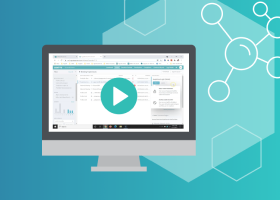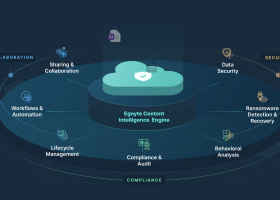What Is an eCRF?
An eCRF (electronic case report form) is a digital questionnaire that is used to collect data about a clinical study and research participants. The data collected in eCRFs is what biostatisticians analyze to draw a conclusion from a study.

Benefits of eCRFs include:
- Allow detailed data collection at distinct times
- Enable sharing of data with all the stakeholders across systems
- Facilitate the collection of accurate observations and reliable findings
- Follow standards for data exchange and compliance
- Provide interoperability features to support multi-center trials
- Secure study participant data
- Standardize data storage for research and clinical care
- Support transparency by providing real-time access to data
Key Features of an eCRF
Key components of an eCRF are:
- Form label—a descriptive title that describes the kinds of questions asked
- Group label—a sub-title used for sections of the form to describe questions in that section
- Item label—a heading used to direct what information should be entered into the field
- Item description—a note that gives specifics about the item information to be entered (e.g., enter in pounds or kilograms)
- Field—a box or blank area where information is entered
- Value—the data that is entered into the field, which can be a drop-down menu with choices
- Choice labels—options for answering a multiple-choice question
- Data validation—message triggered when values are not acceptable
eCRF Design
Designing an effective eCRF requires more than just copying an existing paper CRF into the digital format. An eCRF design must take into account the digital medium as well as the capabilities of the software.
When designing new eCRFs:
- the team conducting the study must define the data elements required to answer the intended questions along with specific data required about the subjects
- the template should include items, groups, and sections, which are linked to annotations of protocols, literature documents, and patient-related medical cases
- any data to be gathered should be detailed, unambiguous, void of redundancies, and not include details that are not related to the study
Considerations for the eCRF design process and notes on how to apply them are as follows.
Keep the eCRF Design Simple
- Take care not to over-complicate eCRFs.
- Pay close attention to the design process.
- Include only inputs that are directly relevant to the study endpoints.
- Do not clutter the eCRF with commentary fields or “other interesting values.”
- Use comment fields only when absolutely necessary.
- Remember that an eCRF is not an electronic health record.
Focus on Clarity in eCRF Design
- Eliminate uncertainty.
- Make questions explicit.
- Incorporate the answer with the question. For example, rather than asking a question with boxes for yes and no underneath it, keep the question and answer together—Yes, I do, or No, I do not.
Make Data Fields Mandatory
- Require that fields be completed in order to finish the form.
- Use mandatory field settings to remind people to complete missed fields or to stop them from proceeding to the next field until the one they are on is completed.
- Include selections for opting out of answering a question by including options, such as “not applicable” or “do not know.”
Acquire Quantifiable Data
- Use pre-defined selections for fields instead of free text whenever possible.
- Use multiple-choice questions with expected answers as the choices.
- Use an “other” box for cases where there could be additional answers.
- Note that free text is difficult to quantify and requires data cleaning.
Reuse Forms
- Create a general form that can be duplicated.
- Build from existing forms.
- Share and exchange forms with collaborators.
Establish Rules for Numeric Inputs
- Define how numbers should be inputted.
- Specify whether to input whole numbers or decimals.
- Use spaces or boxes to ensure inputs are performed correctly (e.g., _._ _).
eCRFs and Clinical Trial Management Systems (CTMS)
Clinical Trial Management Systems (CTMS) support clinical studies by storing subject information and support research operations with planning, benchmarking, and reporting features. CTMSs integrate with other systems, including electronic data capture (EDC) solutions. eCRFs roll up into this ecosystem. Data from eCRFs are collected in EDCs.

eCRFs versus Paper CRFs
Paper CRFs are rapidly being replaced with eCRFs. Paper CRFs are still in use, but eCRFs are used even in places with limited connectivity, since they can be completed offline and uploaded to the system later.
Potential obstacles to eCRFs versus paper CRFs:
- There are no license fees when running a clinical study on paper, which lowers the upfront costs of launching a clinical study.
- No software training is required to use paper-based CRFs.
- With paper CRFs, clinical study data can be physically secured, i.e., stored in files in a physical vault or locked room.
- Paper CRFs can record free-form information using pen and paper at any point in time.
Despite the defensive points in the case of eCRFs versus paper CRFs, there are many benefits of eCRFs and their use continues to grow, quickly overtaking paper CRFs.
eCRF Development
Use Cases
- Understand the study protocol.
- Build evidence-based eCRFs.
- Identify items, groups, and sections linked to annotations of protocols, literature documents, and patient-related medical cases.
Data Management
- Set out the scope, templates, operating procedures, standards, and responsibilities for managing data collection.
- Identify the data items to be collected and the frequency of collection.
- Draw up the database requirements, including:
- Structure of the eCRF components (e.g., events/visit, types of forms, item groups, items)
- Item characteristics (e.g., annotation, types, appearance, field length, mandatory or optional, etc.)
- Dynamic functionalities (e.g., enabling/disabling, repeating, calculations, etc.)
- Specification of system-generated checks (e.g., queries, messages, vetoes)
- Determine if external electronic data (e.g., lab results) should be included.
- Define content, structure, and frequency in data transfer specifications (DTS).
- Test and validate DTS with external providers before the first planned data transfer.
- Program study-specific status reports.
Work-Flow Definition
- Define the roles, rights, and workflows of individuals within the study.
- Identify the staff access to eCRFs—i.e., read, write, and modify data, or raise/answer queries regarding the eCRFs.
System Testing
- Test functionality of all components of the system.
- Review findings and recommendations.
- Implement necessary system updates.
User Acceptance Testing (UAT)
- Develop a general description of how the UAT is set up and of the test scripts to be used.
- Establish the complexity of the UAT, which is driven by the number of variables and edit checks in the eCRF.
- Write and review test scripts for each UAT round (a complete UAT for an average study usually consists of three rounds).
- Report UAT findings to the database programmers.
- Run a second UAT after the database changes have been made.
- Finalize eCRF for use at sites after the last UAT results in zero findings.
System Launch
- All users must be trained in handling the system according to their roles.
- Make training manuals available to all users.
- Transfer to the production environment.
Query Resolution and Data Cleaning
- Check the eCRF data continuously to ensure that it is as accurate and clean as possible.
- Perform data cleaning, including:
- Review the sites’ answers to the automatically generated system queries (e.g., ranges, completeness, consistency), when these are not automatically closed by the system.
- Create and review manual queries based on data checks and database reports.
- Review text fields to prevent errors and to extract important data that automated check rules cannot detect (e.g., protocol deviations, Adverse Events, and “other” fields.
- Sign, freeze, and lock completed forms.
eCRFs Become Default for Clinical Studies
eCRFs present a flexible and versatile integrated solution for managing and capturing quality data during clinical trials. They address many of the data collection challenges that come up in clinical studies. Among the solutions that eCRFs provide are managing data collection for clinical trials that span across several locations as well as monitoring and integrating this data at a single central location.
Although paper CRFs still are in use, clinical studies are phasing them out. The transition to eCRFs is being driven by the time they save as well as the transparency they provide to everyone involved in the clinical study process.
Egnyte has experts ready to answer your questions. For more than a decade, Egnyte has helped more than 16,000 customers with millions of customers worldwide.
Last Updated: 23rd October, 2021




